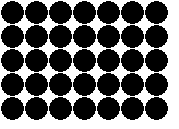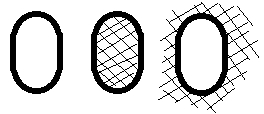| Hypercommunication - Crash Courses - Second-order Systems Theory [ Hyper-Library ] [ Hyper-Lexicon ] [ back ] |
|
|
backward - Seite 23 - forward |
When describing, I distinguish between properties and - mediated by attribution - entities.
|
Differentiation is what I call the operation by which I as an observer create inhomogeneity by naming something. For example, I can perceive a set of spheres as homogeneous or inhomogeneous, depending on whether I distinguish colors or not. I can speak of the spheres or of the red and the other spheres. So whether I make a certain distinction or not does not depend on differences that exist before or independently of my distinguishing. Rather, I can only perceive differences by making distinctions. To recognize that the balls have different colors, I have to distinguish different colors (note 1). I differentiate and separate. I distinguish the two poles of a magnet, but I cannot separate them. In this narrower sense, distinguishing always means holding together (note 2). When I observe my observations, I observe what distinctions I use for, what I gain from a particular distinction, and what I gain when I remove it (note 3). |
|


|
In order to describe something, I have to make distinctions. Every description implies a distinction. I can only observe distinctions as an implication of terms. I can perceive differences in my environment and empathetically I can grant this to every observer. But I cannot observe the differentiation, only the naming. S. Ceccato has receptively projected the distinction as attention into the observer. I want to illustrate the connections with one of his examples:
With a pencil I construct a (stretched circle) figure on a paper. Colloquially I would speak of drawing. The figure represents the distinctions I make. I can direct my attention to the circle line and see, for example, a link in a chain. I call what is black (marked space). What is white I do not pay attention to, it is the unmarked space, the other side of the distinction. I can also direct my attention to unmarked space. Then I observe the background of the object. I call this side of the distinction the "background", and I do not pay attention to the chain link. |
|

|
With another distinction, I can see a tabletop from above by perceiving and naming everything within the drawn line as foreground. I can also see a window, in which I see everything outside the line as foreground. In these cases I consider the circle line only as the limit of distinction. My attention is not on the line, but on one side of the line at a time. In all these cases I make a pictorial statement as an observer, i.e. a picture. I project these images into my receptive area of perception, where I experience my behaviour as perceiving.
|
Look for an example of how distinctions influence perception and action! |
A typical application is the conflict solution, where both parties put on the "glasses" of the other party. Glasses stand for categories or distinctions. |
|
Examples:
|
Formal languages - such as the calculus of G. Spencer-Brown - are constructed by a series of distinctions (note 4). As a logician I say for example: distinguish "a" and "not-a". I start analytically in homogeneous space. As an interpreting observer, I make a vast number of unconscious distinctions that result in my environment. When I make individual parts or aspects of my environment into phenomena, I focus on certain distinctions with which I create the phenomenon in an action context. As an observer I do not start with a single distinction. Therefore I read G. Spencer-Brown's suggestion "Draw a distinction" as "Make yourself aware of your distinction".
The calculation of G. Spencer-Brown is often strained. It is read as an instruction for the creation of the world. God has not only distinguished between light and darkness, land and water, but has separated them. I distinguish between differentiate and separate. The poles of a magnet I can only distinguish but not separate. To fantasize analytically about the earth as the result of a big bang is something different than making the earth with a big bang and then giving light (note 5).
|
|
backward - Seite 23 - forward |